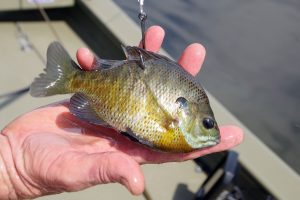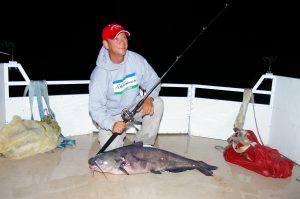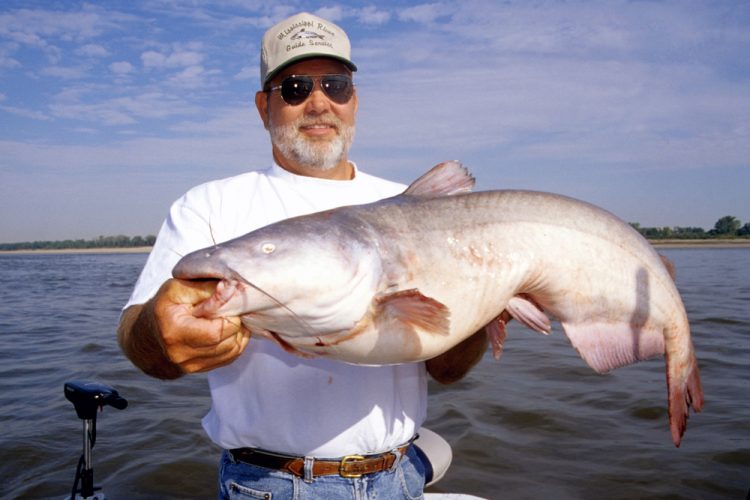Bumping was developed by anglers on the Mississippi River like fishing guide James Patterson
of Bartlett, Tenn. who shows a nice blue cat caught using the technique.
3 Top Tactics for Summer Catfish
by Keith “Catfish” Sutton
When summer catfishing gets tough, having some offbeat tactics in your bag of tricks can help assure success.
Summer catfishing can get pretty aggravating at times. In many parts of the country, whiskerfish hide out in spawning holes this month. Females are laying eggs, and males move in behind them to protect the eggs and fry. Neither sex feeds much until spawning activities end, so the catfish angler must dig deep in his or her bag of tricks to find methods that will nab these tight-lipped fish.
Fortunately, there are plenty of excellent tips you can try to improve your catch rate when summer fishing gets tough. Here are three of them.
Big-River Bumping
When targeting trophy catfish in big rivers, a tactic called bumping should be on your must-learn list. Instead of sitting in one spot and waiting for a fish to follow the scent trail to your bait, bumping is an interactive approach that lets you take the bait to the fish. It’s a natural presentation that mimics food washing downstream to catfish waiting in ambush. The bumping name derives from the feel of the bait bumping across the bottom while you drift.
A modified three-way rig works well for this tactic. The hook line is made of 50-pound braid so it can handle big cats without breaking. The sinker line is lighter mono so if the weight snags, it can easily be broken loose with only the loss of the lead. The weight’s size is based on the amount of current—a lighter weight in lighter current, a heavier weight in faster current. The rig should just bump the bottom while you feed your main line further and further behind the boat.
To begin, bait your hook with a chunk of shad or herring cut-bait, and position your boat over structure you identified earlier. Then point the bow of your boat upstream and use your trolling motor to reduce your drift speed by half or more. If the current is 3 mph, for example, you want to reduce your drift speed to 2 mph or even 1. Now your boat is going slower than the current, so your bait also travels slower downriver. Actively feeding catfish that lay facing upstream behind rocks, logs, ledges and other current breaks are quick to dart out and grab your enticement.
You should not put your rod in a holder while bumping. Keep your fishing combo in your hands. You want to place the reel in free spool and keep releasing line to a point several hundred feet behind the boat. Slightly raise the rod tip, then let out enough line for the bait to contact the bottom again. Let sit for a second and repeat until your rig is 500 feet back.
Ideally, when the bait is properly positioned, it will skip along 6 inches or so at a time. You want to be able to feel every log, rock and contour as your bait travels across the bottom. If the water gets shallower, reel in line to stay in touch. If your rig drops into a hole, let some line out.
Be prepared for a strike whenever you feel a rock, log or other bottom feature. Catfish use such structures as current breaks, and as your bait drops into the pocket on the downstream side, that’s when a battle with a big fish is likely to begin.
Fish The Surface With Sunfish
Because we usually find catfish feeding on the bottom in lakes, rivers and ponds, we tend to think they always feed on bottom. This is a common misconception. In reality, catfish often feed on the surface, too, especially if they sense food animals struggling in the uppermost strata of the water. This is a behavior anglers can take advantage of by using live sunfish for bait.

To do so, rig a 6- to 8-inch-long bluegill, green sunfish or other bream on a short line (6 inches or less) beneath a big float like a Thill 6-inch Big Fish Slider. Hook it just behind the dorsal fin with a 7/0 to 9/0 Boss Wide Boss Kat hook, running the point completely through so the barb is exposed.
The idea is to keep the baitfish near the surface where it will splash. Cast it out and then give the line a short tug at regular intervals to disturb the bream and get it to struggle and splash on the surface. The commotion made by the struggling bait works like a dinner bell, attracting big hungry catfish lurking nearby.
This type of catfishing works best in water just three to eight feet deep. If it’s deeper than that, catfish won’t come up for the bait because they can’t see or hear it splashing. Good locales to try include stump fields where lots of treetops have broken off and are laying in the water, transition areas where a tributary flows into the main portion of a lake, and bottom channels that rise onto shallow flats. These provide deep-water areas where catfish can retreat and shallow-water areas where cats feed at night.
Plan A Night Trip
Many of today’s catfish anglers never fish at night. They should. Fishing during hours of darkness can greatly improve your catch rate, especially if you target your quarry during the wee hours—1 p.m. to 4 p.m.—when most other anglers and recreationists are at home and catfish have moved from deeper water to shallows to feed.

The extent to which you are familiar with prime catfish habitat in a lake, pond or river is important when night fishing. If you must search for good fishing spots in the darkness on an unfamiliar body of water, you could get lost, wind up on top of a stump or sandbar, or something worse. You’ll be better off fishing waters you already know or doing some advance scouting during daylight hours. You’ll catch more catfish if you can travel safely and directly to prime bank-fishing or boat-fishing locales you’ve previously identified and marked.
Putting waypoints in your GPS is helpful if you’ll be fishing from a boat, and before fishing, you also may want to flag your fishing areas with marker buoys. The best places tend to provide catfish with distinct travel routes from deeper daytime haunts to shallower near-shore reaches used for night feeding. These include points, humps, creek channels, ledges and ridges.
To avoid problems prepping gear in the darkness, have your fishing combos rigged and ready to use, and organize your tacklebox before fishing so you’ll know exactly where everything is. Be sure you have fully charged batteries for all your navigation and fishing lights.
Boat fishermen will want anchors with an adequate length of rope to hold the boat stationary, and all night fishermen will want a good supply of insect repellent or devices such as the Thermacell to ward off mosquitoes. Wear a lifejacket and kill-switch at all times, and let someone know where you plan to fish and when you plan to return.
(Keith “Catfish” Sutton lives in Alexander, Arkansas with his wife Theresa. He has written four books on catfishing, including the latest, Hardcore Catfishing: Beyond the Basics. In 2022, he was one of the inaugural inductees in the American Catfishing Association’s Catfishing Hall of Fame.)



